KeyError: 0 exception in Python [Solved]
Last updated: Apr 8, 2024
Reading time·8 min

# Table of Contents
- KeyError: 0 exception in Python
- KeyError exception when assigning new Key in Python
- (JSON) KeyError exception in Python
# KeyError: 0 exception in Python
The Python "KeyError: 0" exception is caused when we try to access a 0 key
in a dictionary that doesn't contain the key.
To solve the error, set the key in the dictionary before trying to access it
or use dict.get() to get a default value if the key doesn't exist.

Here is an example of how the error occurs.
my_dict = {1: ['c', 'd'], 2: ['e', 'f']} # ⛔️ KeyError: 0 print(my_dict[0])
We tried accessing a 0 key in a dictionary that doesn't contain it.
# Using the dict.get() method
One way to avoid the exception is to use the dict.get() method.
my_dict = {1: ['c', 'd'], 2: ['e', 'f']} print(my_dict.get(0)) # 👉️ None print(my_dict.get(0, 'default value')) # 👉️ default value
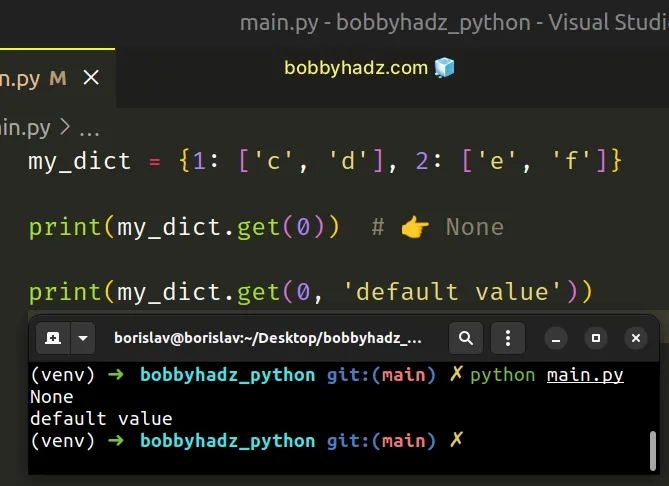
The dict.get() method returns the value for the given key if the key is in the dictionary, otherwise a default value is returned.
The method takes the following 2 parameters:
| Name | Description |
|---|---|
| key | The key for which to return the value |
| default | The default value to be returned if the provided key is not present in the dictionary (optional) |
If a value for the default parameter is not provided, it defaults to None,
so the get() method never raises a KeyError.
You can use any default value that suits your use case, e.g. None, 0 or an
empty string.
my_dict = {1: ['c', 'd'], 2: ['e', 'f']} print(my_dict.get(0, None)) # 👉️ None print(my_dict.get(0, 0)) # 👉️ 0 print(my_dict.get(0, '')) # 👉️ ""
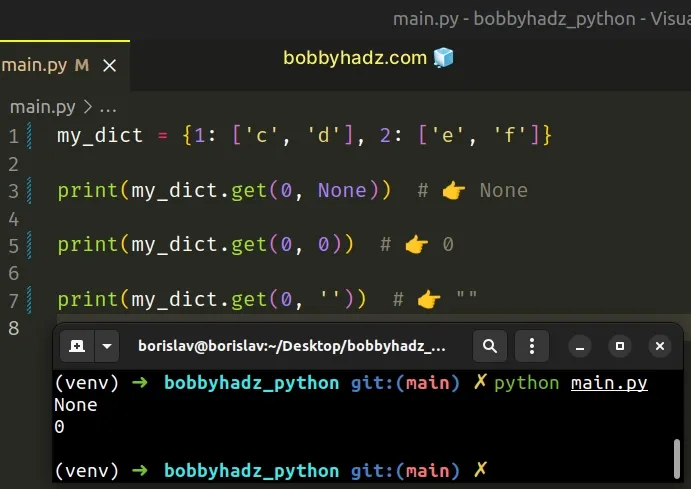
# Set a value for the key before accessing it
Another way to solve the error is to set a value for the specific key before trying to access it.
my_dict = {1: ['c', 'd'], 2: ['e', 'f']} my_dict[0] = [] # 👈️ initialize key to empty list my_dict[0].append('a') my_dict[0].append('b') print(my_dict[0]) # 👉️ ['a', 'b']
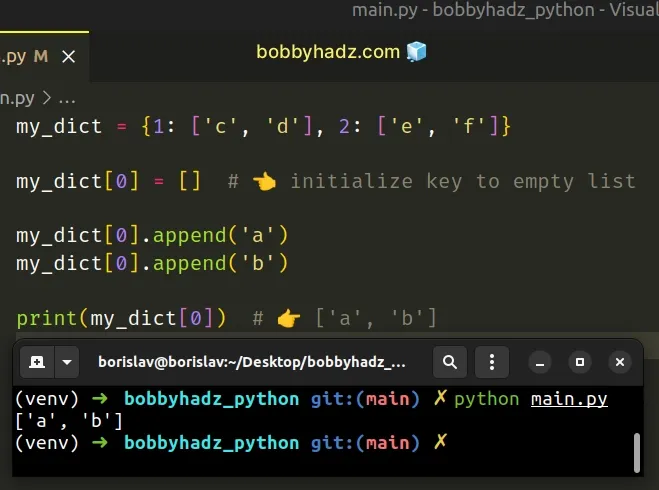
We initialized the 0 key to an empty list in the example.
Now we can safely access the key without getting a KeyError exception.
# Checking if the key doesn't exist before setting it
You can also check if the key doesn't exist in the dictionary before setting it.
my_dict = {1: ['c', 'd'], 2: ['e', 'f']} # ✅ initialize key if it doesn't exist if 0 not in my_dict: my_dict[0] = [] my_dict[0].append('a') my_dict[0].append('b') print(my_dict[0]) # 👉️ ['a', 'b']
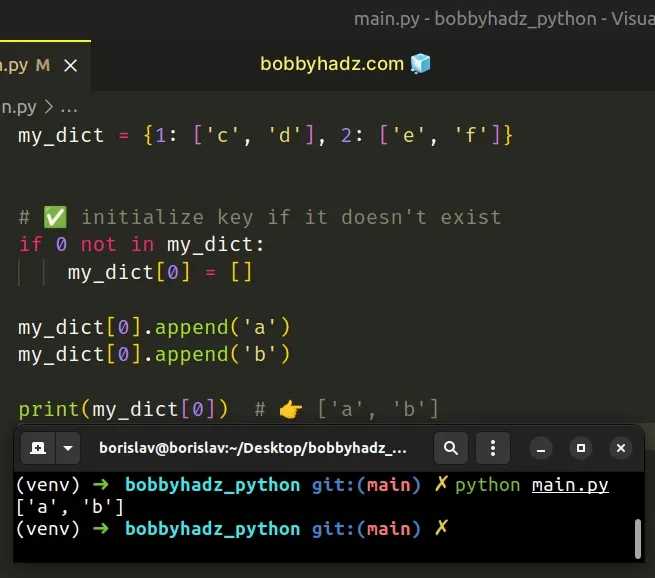
We check if the 0 key doesn't exist in the dictionary and initialize its value
to an empty list.
# Using a try/except statement to handle the error
You can also use a try/except statement to handle the error.
my_dict = {1: ['c', 'd'], 2: ['e', 'f']} try: print(my_dict[0]) except KeyError: # 👇️ this runs print('key does not exist in dict') my_dict[0] = [] # 👈️ can initialize key if necessary
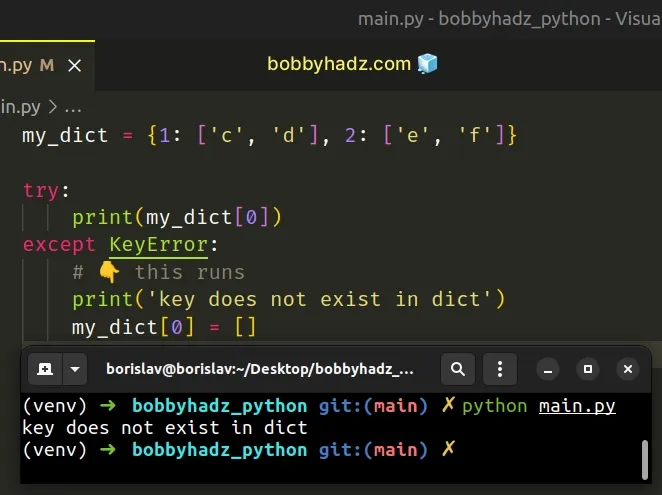
Trying to access the 0 key in the dictionary causes a KeyError exception
which then gets passed to the except block.
The KeyError exception gets handled by the except clause where you can
initialize the 0 key if necessary.
# Use the dict.items() method to iterate over a dictionary
Use the dict.items() method if you need to iterate over a dictionary.
my_dict = {0: ['a', 'b'], 1: ['c', 'd'], 2: ['e', 'f']} for key, value in my_dict.items(): print(key, value) # 0 ['a', 'b'], 1 ['c', 'd'], 2 ['e', 'f']
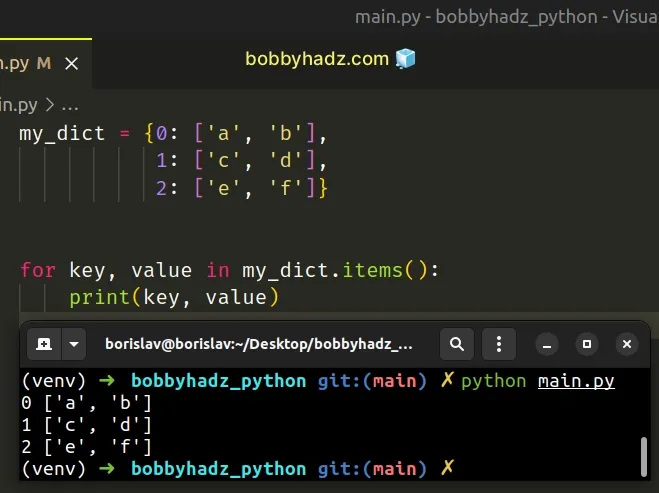
The dict.items method returns a new view of the dictionary's items ((key, value) pairs).
You can also use the range() class when iterating over a dictionary.
my_dict = {1: ['b'], 3: ['c'], 5: ['d']} for index in range(0, 10): if index in my_dict: # ['b'] # ['c'] # ['d'] print(my_dict[index])
The for loop uses the range class to get an
iterator from 0 to 9.
# [0, 1, 2, 3, 4, 5, 6, 7, 8, 9] print(list(range(0, 10)))
On each iteration, we check if the index is present in the dictionary before accessing it.
# Using the defaultdict class to solve the error
You can also use the defaultdict class to avoid the error.
from collections import defaultdict my_dict = defaultdict(list) my_dict[0].append('a') my_dict[0].append('b') print(my_dict) # 👉️ defaultdict(<class 'list'>, {0: ['a', 'b']})
Notice that you have to import the defaultdict class before using it.
The
defaultdict
class takes a default_factory argument which it calls to provide a default
value for the given key.
The value for the key is inserted in the dictionary and is returned.
We passed the list class to the constructor, so every time we try to access a
key that doesn't exist, the list class is called without any arguments and a
list object is set for the key.
# KeyError exception when assigning new Key in Python
A KeyError exception is raised when assigning a new key in a dictionary when trying to assign a nested key.
To solve the error, conditionally set the key or use the defaultdict class
to set a default value for keys that don't exist in the dictionary.
Here is an example of how the error occurs.
employee = { 'name': 'Bobby Hadz' } # ⛔️ KeyError: 'address' employee['address']['country'] = 'Austria'
We tried to assign a nested key in the dictionary, however the address key
doesn't exist, so we got a KeyError exception.
# Assigning a value for the key first
One way to solve the error is to assign a value for the address key first.
employee = { 'name': 'Alice' } employee['address'] = {} # 👈️ assign key to empty dict employee['address']['country'] = 'Austria' # 👇️ {'name': 'Alice', 'address': {'country': 'Austria'}} print(employee)
We set the address key to an empty dictionary, so we were able to assign the
nested country key.
address key if it were already set in the dictionary.# Checking if the key exists before assigning a value
You can only assign the key if it isn't already present in the dictionary.
employee = { 'name': 'Alice' } if 'address' not in employee: employee['address'] = {} employee['address']['country'] = 'Austria' # 👇️ {'name': 'Alice', 'address': {'country': 'Austria'}} print(employee)
The if statement is only run if the address key is not in the dictionary.
# Using the defaultdict class to set a default value for keys that don't exist
You can also use the defaultdict class to set default values for keys that
don't already exist in the dictionary.
from collections import defaultdict employee = defaultdict(dict) employee['address']['country'] = 'Austria' # 👇️ defaultdict(<class 'dict'>, {'address': {'country': 'Austria'}}) print(employee) print(employee['address']) # 👉️ {'country': 'Austria'}
The
defaultdict()
class takes a default_factory argument which it calls to provide a default
value for the given key.
The value for the key is inserted in the dictionary and is returned.
We passed the dict class to the constructor, so every time we try to access a
key that doesn't exist, the dict class is called without any arguments and a
dict object is set for the key.
Here is a simple example of how defaultdict objects work.
from collections import defaultdict my_dict = defaultdict(int) print(my_dict['a']) # 👉️ 0
The a key is not present in the dict, so the
int() class gets invoked
without any arguments and a 0 value gets set for the key we tried to access.
# Using a try/except statement when setting the key
You can also use a try/except statement to handle a KeyError exception while
adding a new key to a dictionary.
employee = { 'name': 'Alice' } try: employee['address']['country'] = 'Austria' except KeyError: employee['address'] = {} employee['address']['country'] = 'Austria' # 👇️ {'name': 'Alice', 'address': {'country': 'Austria'}} print(employee)
The KeyError exception gets handled by the except clause where we assign the
address key and set a value for the nested country key.
# (JSON) KeyError exception in Python
To solve the (JSON) KeyError exception in Python, use the json.loads()
method to parse the JSON string into a native Python object and conditionally
check if the key is present in the dictionary before accessing it.
import json my_json = r'{"name": "Alice", "age": 30}' # 👇️ Parse JSON string to Python dict my_dict = json.loads(my_json) print(my_dict) # 👉️ {'name': 'Alice', 'age': 30} # 👇️ Check if the key is present in the dictionary if 'country' in my_dict: print(my_dict['country'])
The json.loads() method parses a JSON string into a native Python object.
We used the in operator to check if the country key is present in the
dictionary before accessing it.
dict object.# Setting the key to a default value if it isn't present
Alternatively, you can check if the key is not in the dictionary and set it to a default value, e.g. an empty string or an empty list.
import json my_json = r'{"name": "Alice", "age": 30}' my_dict = json.loads(my_json) print(my_dict) # 👉️ {'name': 'Alice', 'age': 30} if 'country' not in my_dict: my_dict['country'] = '' print(my_dict['country']) # 👉️ ''
We only set the country key to an empty string if it isn't already present in
the dictionary.
When debugging, use the dict.keys() method to print the dictionary's keys.
import json my_json = r'{"name": "Alice", "age": 30}' my_dict = json.loads(my_json) print(my_dict) # 👉️ {'name': 'Alice', 'age': 30} # 👇️ ['name', 'age'] print(list(my_dict.keys()))
If you try to access any other key, you'll get the KeyError exception.
# Ignoring the KeyError exception
If you only need to access a specific key and need to ignore the KeyError
exception, use the dict.get() method.
import json my_json = r'{"name": "Alice", "age": 30}' my_dict = json.loads(my_json) print(my_dict) # 👉️ {'name': 'Alice', 'age': 30} print(my_dict.get('country')) # 👉️ None print(my_dict.get('country', 'default value')) # 👉️ 'default value'
The dict.get() method returns the value for the given key if the key is in the dictionary, otherwise a default value is returned.
The method takes the following 2 arguments:
| Name | Description |
|---|---|
| key | The key for which to return the value |
| default | The default value to be returned if the provided key is not present in the dictionary (optional) |
If a value for the default parameter is not provided, it defaults to None,
so the get() method never raises a KeyError.
# Make sure to access the key correctly
Make sure you aren't trying to access the key incorrectly.
import json my_json = r'{"address": {"country": "Austria"}}' my_dict = json.loads(my_json) print(my_dict) # 👉️ {'address': {'country': 'Austria'}} print(my_dict['address']['country']) # 👉️ 'Austria'
Notice that we first have to access the address key before accessing the
nested country key.
If you have an array, make sure to access it at a specific index before trying to access a key.
import json my_json = r'[{"address": {"country": "Austria"}}]' my_list = json.loads(my_json) print(my_list) # 👉️ [{'address': {'country': 'Austria'}}] print(my_list[0]['address']['country']) # 👉️ 'Austria'
We parsed the JSON string into a list. Notice that we first have to access the
list at index 0 to get a dict object.
Once we have a dict object, we can access its specific keys.
# Additional Resources
You can learn more about the related topics by checking out the following tutorials:
- Using dot "." notation to access dictionary keys in Python
- Using a variable to access a dictionary Key in Python
- Get multiple values from a Dictionary in Python
- Get random Key and Value from a Dictionary in Python
- UserWarning: Could not import the lzma module. Your installed Python is incomplete
- Mock multiple return values in a Python unit Test
- Unable to initialize device PRN in Python [Solved]
- Configure error: no acceptable C compiler found in $PATH
- bs4.FeatureNotFound: Couldn't find a tree builder with the features you requested: lxml

